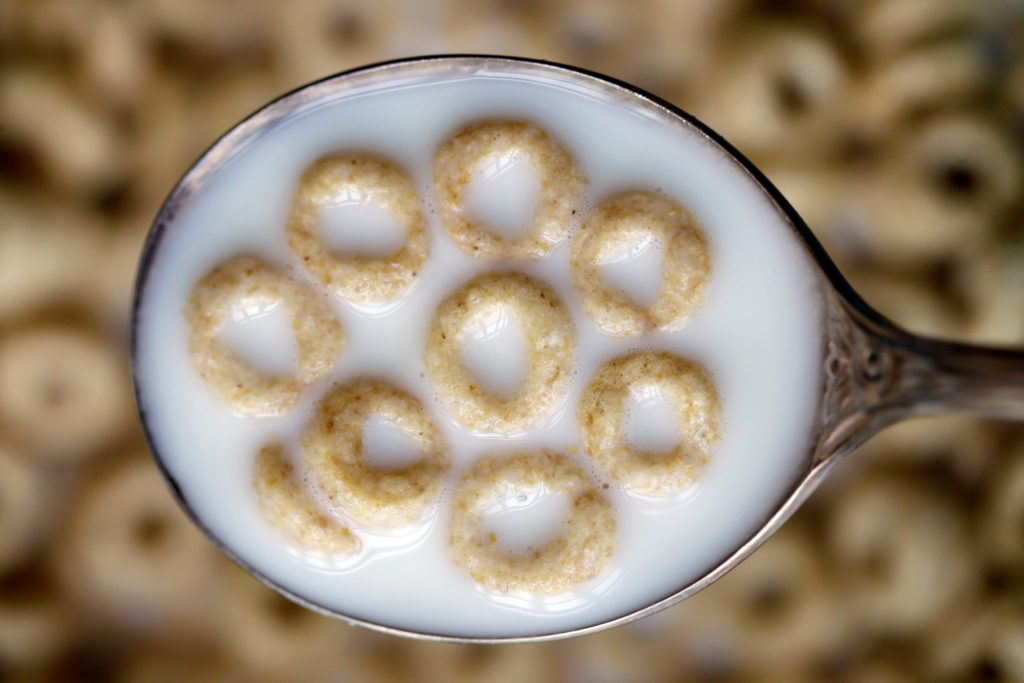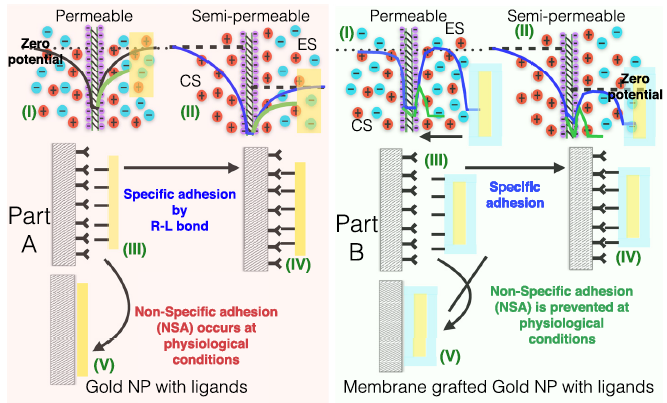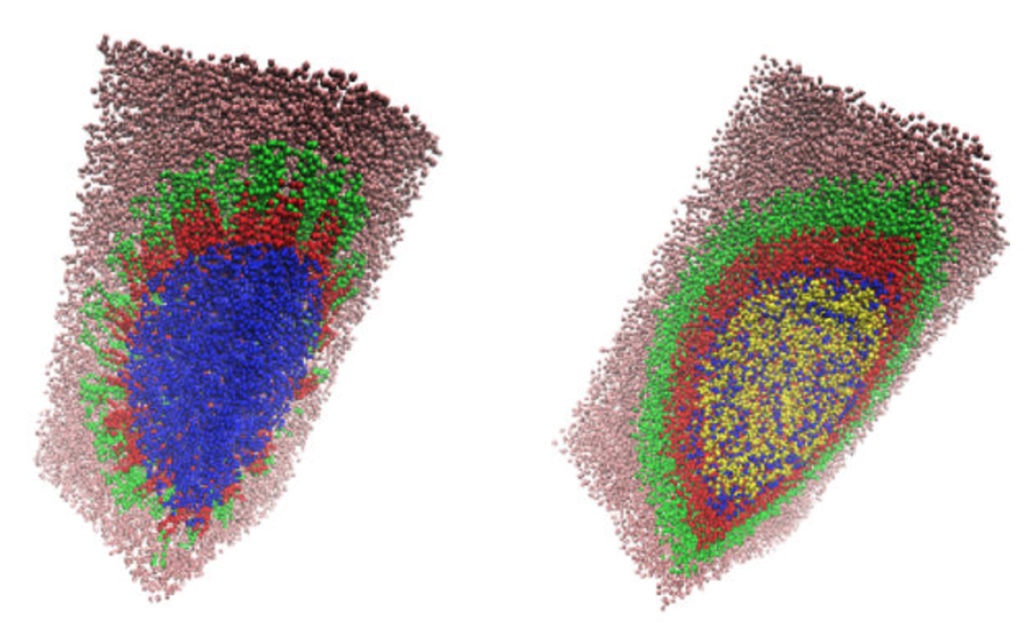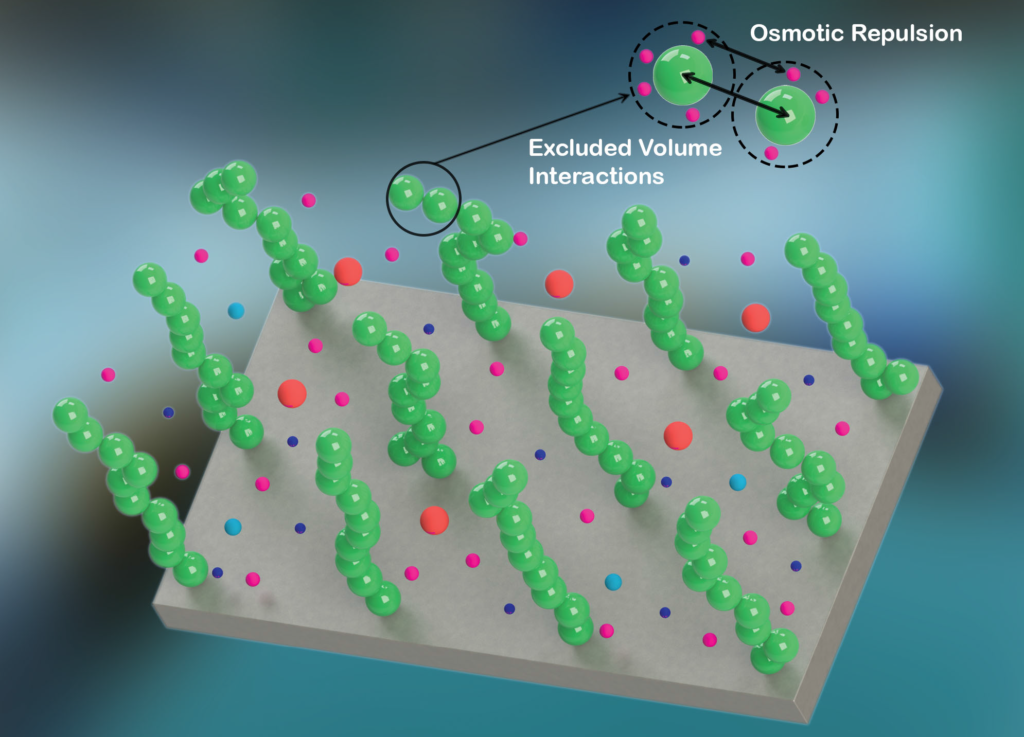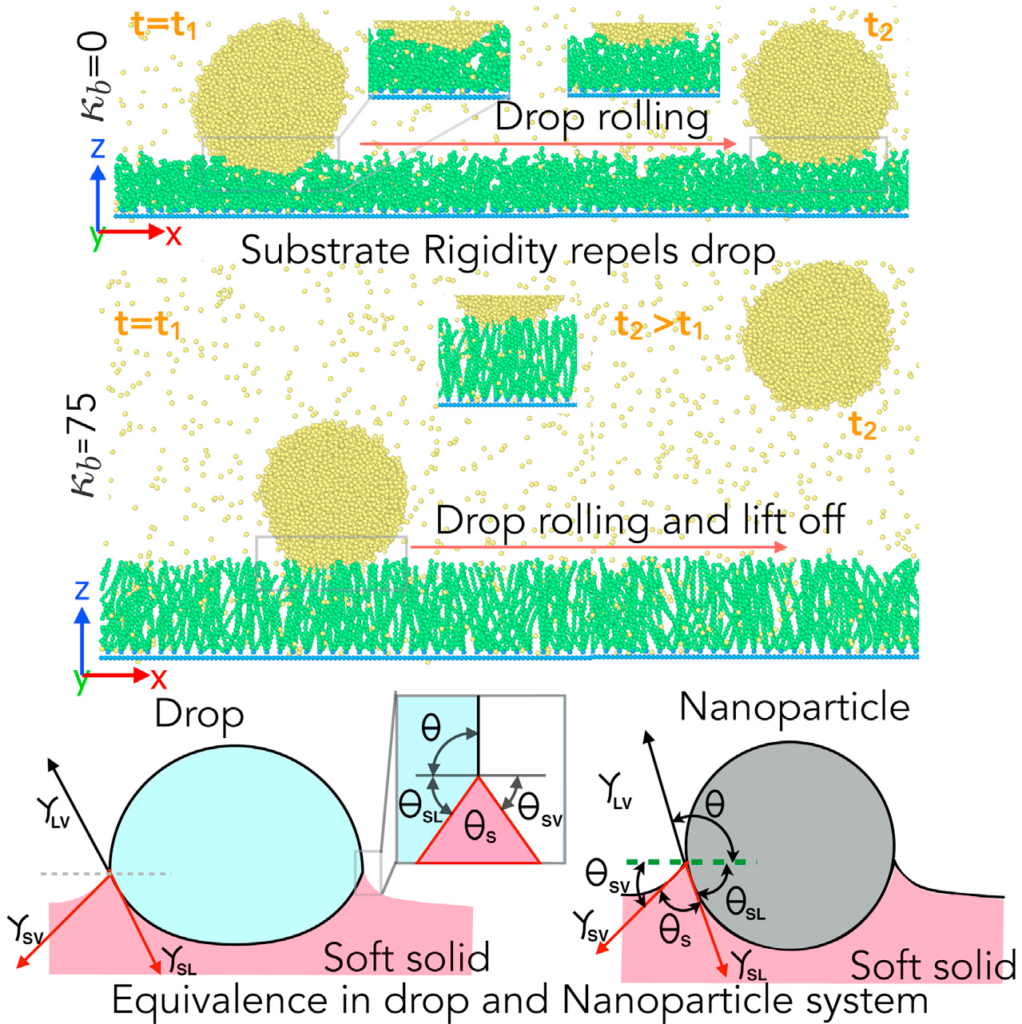a. Wetting of soft deformable surfaces
This research area focuses on understanding the interactions of liquid drops with soft, deformable substrates. On substrates that deform under the action of the surface tension forces of the liquid drops, an intriguing interplay of the solid-liquid interactions ensure different static and dynamic behaviors of the liquid drops. The applications of this topic range from exploring the substrate mediated coalescence for additive manufacturing applications to developing new cancer therapies based on the arrest of migration of tumor cells on soft surfaces.
Collaboration: Prof. Jacco Snoeijer (Univ. of Twente)
Involved Graduate Students (Present):
Involved Graduate Students (Past): Haoyuan Jing, Shayandev Sinha
Related recent publications
- P. R. Desai#, Y. Wang#, H. S. Sachar#, H. Jing#, S. Sinha#, and S. Das*, “Supersolvophobic Soft Wetting: Nanoscale Elastocapillarity, Adhesion, and Retention of a Drop Behaving as a Nanoparticle” Matter, DOI: 10.1016/j.matt.2019.07.001 (2019).
- Karpitschka, S. Das, M. van Gorcum, H. Perrin, B. Andreotti, and J. H. Snoeijer, “Soft Wetting: Models based on energy dissipation or on force balance are equivalent.” Proceedings of the National Academy of Sciences, USA, DOI: 10.1073/pnas.1808870115 (2018).
- A. Pandey, S. Karpitschka, L. A. Lubbers, J. H. Weijs, L. Botto, S. Das, B. Andreotti, and J. H. Snoeijer, “Dynamical Theory of the Inverted Cheerios Effect.” Soft Matter, 13, 6000-6010 (2017).
- H. Jing#, S. Sinha#, and S. Das*, “Elasto-electro-capillarity: Drop equilibrium on a charged, elastic solid.” Soft Matter, 13, 554-566 (2017).
- S. Karpitschka, et al., “Inverted Cheerios effect: Liquid drops attract or repel by elasto-capillarity.” Proceedings of the National Academy of Sciences, USA, 113, 7403-7477 (2016)
- S. Karpitschka, et al. “Droplets move over viscoelastic substrates by surfing a ridge.” Nature Communications 4, 7891(1-6) (2015).
- L. A. Lubbers, et al., “Drops on soft solids: Free energy and double transition of contact angles Journal of Fluid Mechanics 747, R1 (2014).
b. Electrostatics and Adhesion of membranes and bilayers
This research area focuses on developing novel theoretical and molecular dynamics simulation models to better understand (a) the electrostatic and charging of membranes and lipid bilayers (b) charge-driven adhesive interactions of nanoparticle with such membranes and bilayers, and (c) behavior, energetics, and interactions of nanovesicles and nanoparticle-supported lipid bilayers. The applications of such understanding range from devising more efficient nanoparticle-based drug delivery system to employing nanovesicle-models to understand the behavior of bio-nanomaterials like exosomes and extracellular vesicles.
Collaboration: Dr. Kumaran Ramamurthi (National Cancer Institute, NIH)
Involved Graduate Students (Present): Haoyuan Jing, Harnoor Singh Sachar, Vishal Sankar Sivasankar, Sai Ankit Etha
Involved Graduate Students (Past): Shayandev Sinha
Thesis resulting from this topic: BILAYER MEMBRANE ELECTROSTATICS AND CHARGE-REGULATED MEMBRANE-NANOPARTICLE INTERACTIONS (PhD Thesis of Mr. Shayandev Sinha)
Sponsors: NCI-UMD
Related recent publications
- H. Jing#, Y. Wang#, P. R. Desai#, K. Ramamurthi, and S. Das*, “Formation and Properties of Self-Assembled Nanoparticle-Supported Lipid Bilayer Probed Through Molecular Dynamics Simulations.” Langmuir, 36, 5524–5533 (2020).
- S. A. Etha#, V. S. Sivasankar#, H. S. Sachar#, and S. Das*, “Coating for Preventing Non-Specific Adhesion Mediated Biofouling in Salty Systems: Effect of the Electrostatic and van der Waals Interactions.” Electrophoresis, DOI: 10.1002/elps.201900348.
- H. S. Sachar#, V. S. Sivasankar#, and S.Das*, “Electrostatics and Interactions of an Ionizable Silica Nanoparticle Approaching a Plasma Membrane.” Langmuir, 35, 4171-4181 (2019).
- H. Jing#, S. Sinha#, H. S. Sachar#, and S. Das*, “Interactions of Gold and Silica Nanoparticles with Plasma Membranes Get Distinguished by the van der Waals Forces: Implications for Drug Delivery, Imaging, and Theranostics.” Colloids and Surfaces B: Biointerfaces, 177, 433-439 (2019).
- H. Jing#, Y. Wang#, P. R. Desai#, K. S. Ramamurthi, and S. Das*, “Nanovesicles versus Nanoparticle-Supported Lipid Bilayers: Massive Differences in Bilayer Structures and in Diffusivities of Lipid Molecules and Nanoconfined Water.” Langmuir, 35, 2702-2708 (2019).
- S. Sinha#, H. S. Sachar#, and S. Das*, “Electrostatically-motivated design of biomimetic nanoparticles: Promoting specific adhesion and preventing nonspecific adhesion simultaneously.” Applied Physics Letters, 112, 243702(1-5) (2018).
- S. Sinha#, H. Jing#, H. S. Sachar#, S. Das*, “Surface charges promote non-specific nanoparticle adhesion to stiffer membranes.” Applied Physics Letters, 112, 163702(1-5) (2018).
- S. Sinha#, H. S. Sachar#, and S. Das*, “Effect of plasma membrane semi-permeability in making the membrane electric double layer capacitances significant.” Langmuir, 34, 1760-1766 (2018).
- H. Jing# and S. Das*, “Electric Double Layer electrostatics of lipid-bilayer-encapsulated nanoparticles: Towards a better understanding of protocell electrostatics.” Electrophoresis, 39, 752-759 (2018).
- S. Sinha#, H. Jing#, H. S. Sachar#, S. Das*, “Role of plasma membrane surface charges in dictating the feasibility of membrane-nanoparticle interactions.” Applied Physics Letters, 111, 263702 (2017).
- S. Sinha#, H. Jing#, and S. Das*, “Positive zeta potential of a negatively-charged semi-permeable plasma membrane.” Applied Physics Letters, 111, 063702 (2017).
- S. Sinha#, H. Jing#, and S. Das*, “Charge Inversion and External Salt Effect in Semi-Permeable Membrane Electrostatics.” Journal of Membrane Science, 533, 364-377 (2017).
- S. Sinha# and S. Das*, “Role of Shuttleworth effect in adhesion on elastic surfaces.” MRS Advances (DOI: 10.1557/adv.2016.218) (2016).
- S. Sinha# and S. Das*, “Under-water adhesion of rigid spheres on soft, charged surfaces.” Journal of Applied Physics, 118, 195306 (2015).
c. Polymer and Polyelectrolyte Brushes
This research area focuses on developing novel theoretical and molecular dynamics simulation models to better understand the thermodynamics and transport at surfaces grafted with polymer and polyelectrolyte molecules occupying “brush-like” configuration. The applications are in designing nanoscale interfaces for improved sensing, current rectification, efficient nanoparticle-based drug delivery and oil recovery, and many more.
Involved Graduate Students (Present): Harnoor Singh Sachar, Turash Haque Pial, Vishal Sankar Sivasankar, Parth Rakesh Desai, Sai Ankit Etha
Involved Graduate Students (Past): Guang Chen, Jahin Patwary, Raja Maheedhara
Thesis resulting from this topic: NANOCONFINED POLYELECTROLYTE BRUSHES: THERMODYNAMICS, ELECTROSTATICS AND TRANSPORT (PhD Thesis of Ms. Guang Chen); ENHANCED DIFFUSIOOSMOSIS AND THERMOOSMOSIS IN POLYELECTROLYTE-BRUSH-FUNCTIONALIZED NANOCHANNELS (MS Thesis of Mr. Raja Maheedhara); ENERGY CONVERSION IN NANOCHANNELS GRAFTED WITH POLYELECTROLYTE AND POLYZWITTERION BRUSHES (MS Thesis of Mr. Jahin Patwary)
Sponsors: DOE (Office of Science)
Related recent publications
- H. S. Sachar#, T. H. Pial#, and S. Das*, “All-atom Molecular Dynamics Simulations of Weak Polyionic Brushes: Influence of Charge Density on the Properties of Polyelectrolyte Chains, Brush-Supported Counterions, and Water Molecules.” Soft Matter, DOI: 10.1039/D0SM01000F (2020).
- V. S. Sivasankar#, S. A. Etha#, H. S. Sachar#, and S. Das*, “Theoretical study on the massively augmented electroosmotic water transport in polyelectrolyte brush functionalized nanoslits.” Physical Review E, 102, 013103 (2020).
- S. A. Etha#, V. S. Sivasankar#, H. S. Sachar#, and S. Das*, “Strong Stretching Theory for pH-Responsive Polyelectrolyte Brushes in Large Salt Concentrations.” Physical Chemistry Chemical Physics, 22, 13536-13553 (2020).
- V. S. Sivasankar#, S. A. Etha#, H. S. Sachar#, and S. Das*, “Ionic Diffusioosmotic Transport in Nanochannels Grafted with pH-responsive Polyelectrolyte Brushes Modelled Using Augmented Strong Stretching Theory.” Physics of Fluids, 32, 042003 (2020).
- H. S. Sachar#, T. H. Pial#, P. R. Desai#, S. A. Etha#, Y. Wang#, P. W. Chung, and S. Das*, “Densely Grafted Polyelectrolyte Brushes Trigger “Water-in-Salt” like Scenarios and Ultraconfinement Effect.” Matter, DOI: 10.1016/j.matt.2020.02.022. (Topic: P) (media coverage: UMDRIGHTNOW; enme.umd.edu)
- H. S. Sachar#, V. S. Sivasankar#, S. A. Etha#, G. Chen, and S. Das*, “Ionic Current in Nanochannels Grafted with pH-Responsive Polyelectrolyte Brushes Modelled Using Augmented Strong Stretching Theory.” Electrophoresis, DOI: 10.1002/elps.201900248 (2019).
- H. S. Sachar#, V. S. Sivasankar#, and S. Das*, “Electrokinetic Energy Conversion in Nanochannels Grafted with pH-responsive Polyelectrolyte Brushes Modelled Using Augmented Strong Stretching Theory.” Soft Matter, 15, 5973-5986 (2019).
- K. Jiang, F. Khan, J. Thomas, P. R. Desai#, A. Phani, S. Das*, and T. Thundat, “Thermomechanical Responses of Microfluidic Cantilever Capture DNA Melting and Properties of DNA Pre-melting States Using Picolitres of DNA Solution.” Applied Physics Letters, 114, 173703 (2019).
- H. S. Sachar#, V. S. Sivasankar#, and S.Das*, “Revisiting the Strong Stretching Theory for pH-Responsive Polyelectrolyte Brushes: Effects of Consideration of Excluded Volume Interactions and an Expanded Form of the Mass Action Law.” Soft Matter, 15, 559-574 (2019) (Selected as the Back Cover Article).
- G. Chen#, J. Patwary#, H. S. Sachar#, and S. Das*, “Electrokinetics in nanochannels grafted with poly-zwitterionic brushes.” Microfluidics and Nanofluidics, 22, 122 (2018).
- R. S. Maheedhara#, H. Jing#, H. S. Sachar#, and S. Das*, “Highly enhanced liquid flows via thermoosmotic effects in soft and charged nanochannels.” Physical Chemistry Chemical Physics, 20, 24300-24316 (2018).
- P. R. Desai# and S. Das*, “Lubrication in polymer brush bilayers in weak interpenetration regime: Molecular dynamics simulations and scaling theories.” Physical Review E, 98, 022503 (2018).
- R. S. Maheedhara#, H. S. Sachar#, H. Jing#, and S. Das*, “Ionic Diffusoosmosis in Nanochannels Grafted with End-charged Polyelectrolyte Brushes.” The Journal of Physical Chemistry B, 122, 7450-7461 (2018).
- G. Chen#, H. S. Sachar#, and S. Das*, “Efficient Electrochemomechanical Energy Conversion in Nanochannels Grafted with End-charged Polyelectrolyte Brushes at Medium and High Salt Concentration.” Soft Matter, 14, 5246-5255 (2018).
- P. R. Desai#, S. Sinha#, and S. Das*, “Polyelectrolyte Brush Bilayers in Weakly Interpenetration Regime: Scaling Theory and Molecular Dynamics Simulations.” Physical Review E, 97, 032503(1-8) (2018).
- P. R. Desai#, S. Sinha#, and S. Das*, “Compression of polymer brushes in weak interpenetration regime: Scaling Theory and Molecular Dynamics Simulations.” Soft Matter, 13, 4159-4166 (2017).
- G. Chen# and S. Das*, “Massively enhanced electroosmotic transport in nanochannels grafted with end-charged polyelectrolyte brushes.” The Journal of Physical Chemistry B, 121, 3130-3141 (2017).
- G. Chen# and S. Das*, “Thermodynamics, electrostatics, and ionic current in nanochannels grafted with pH-responsive end-charged polyelectrolyte brushes.” Electrophoresis, 38, 720-729 (2017).
- H. Li#, G. Chen#, and S. Das*, “Electric double layer electrostatics of pH-responsive spherical polyelectrolyte brushes in the decoupled regime.” Colloids and Surfaces B: Biointerfaces, 147, 180-190 (2016).
- G. Chen# and S. Das*, “Anomalous shrinking-swelling of nano-confined end charged polyelectrolyte brushes: Interplay of confinement and electrostatic effects.” Journal of Physical Chemistry B, 120, 6848-6857 (2016).
- G. Chen#, H. Li#, and S. Das*, “Scaling relationships for spherical polymer brushes revisited.” Journal of Physical Chemistry B, 120, 5272-5277 (2016).
- J. Patwary#, G. Chen#, and S. Das*, “Efficient electrochemomechanical energy conversion in nanochannels grafted with polyelectrolyte layers with pH-dependent charge density.” Microfluidics and Nanofluidics 20, 37 (2016).
- G. Chen# and S. Das*, “Scaling laws and ionic current inversion in polyelectrolyte-grafted nanochannels.” Journal of Physical Chemistry B, 119, 12714-12726 (2015).
- S. Das*, M. Banik, G. Chen#, S. Sinha#, and R. Mukherjee, “Polyelectrolyte brushes: Theory, modelling, synthesis, and applications.” Soft Matter, DOI: 10.1039/C5SM01962A (2015).
- G. Chen# and S. Das*, “Electroosmotic transport in polyelectrolyte-grafted nanochannels with pH-dependent charge density.” Journal of Applied Physics, 117, 185304 (2015).
- K. McDaniel#, F. Valcius#, J. Andrews#, and S. Das*, “Electrostatic potential distribution of a soft spherical particle with a charged core and pH dependent charge density”. Colloids and Surfaces B: Biointerfaces, 127, 143 (2015) (Selected as cover article for March issue of the journal).
- G. Chen# and S. Das*, “Streaming potential and electroviscous effects in soft nanochannels beyond Debye-Hückel linearization”, Journal of Colloid and Interface Science, 445, 357 (2015).
- G. Chen# and S. Das*, “Electrostatics of soft charged interfaces with pH-dependent charge density: Effect of consideration of appropriate hydrogen ion concentration distribution”. RSC Advances, 5, 4493 (2015).
- J. Andrews# and S. Das*, “Effect of finite ion sizes in electric double layer mediated interaction force between two soft charged plates.” RSC Advances, 5, 46873-46880 (2015).
- S. Das*, “Explicit interrelationship between Donnan and surface potentials and explicit quantification of capacitance of charged soft interfaces with pH-dependent charge density”, Colloids and Surfaces A: Physicochemical and Engineering Aspects, 462, 69 (2014).
- S. Chanda#, S. Sinha, and S. Das*, “Streaming potential and electroviscous effects in soft nanochannels: Towards designing more efficient nanofluidic electrochemomechanical energy converter”, Soft Matter, 10, 7558 (2014).
